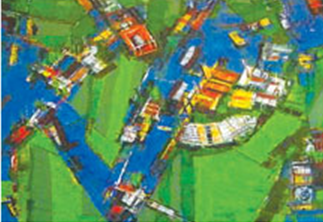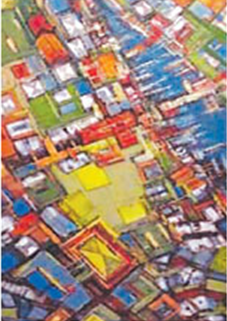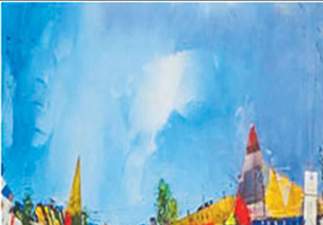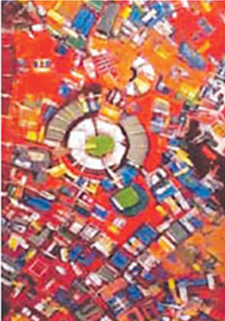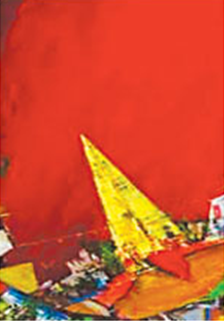Kazi Salahuddin Ahmed
This is a collection of articles archived for the excellence of their content. Readers will be able to edit existing articles and post new articles directly |
Kazi Salahuddin Ahmed
Bird’s eye view
In Kazi Salahuddin Ahmed’s work it is the expressive paint quality that holds the attention. Declaring the power of colour, brilliant aerial views resembling patchwork designs are the artist’s impression of overcrowded towns. The gradual encroachment of every available scrap of green or bare earth is the driving force behind his work. Salahuddin's exhibition of paintings titled, ‘Urbanization’, was held at the Canvas Gallery, Karachi. In his work abstract and figurative elements combine in unexpected ways depicting the world as he sees it through impulsive, energetic shapes.
Addressing his work, Salahuddin explains, are issues concerning ruthless Developers who are snatching up land regardless of future planning. He has grave fears for the environment which is changing before his eyes. In a city where buildings spring up and people crowd in, the future generations will have to move out and find a home elsewhere.
The artist’s paintings show skies veiled with pollution, glimpses of original clear blue, shine through curtains of dust. In a sequence titled: City of Memories, Salahuddin reconstructs the area of Dhaka he grew up in, where people lived peaceably side by side. Using acrylic paints on paper, he uses gradient shades of yellow, orange and blue as predominant hues depicting the upper atmosphere overlooking the busy streets. Collage elements are introduced in the form of sweet wrappers, scraps of paper and tickets, all the recollections of school days.
Portraying his city from above, the artist offers a welcome relief in the presence of the sea, a slim, blue slip of colour bordering the frenetic patterns of the streets. There is a lot of movement in the paintings; one appears to look down at circles, decreasing but still vibrant. The warm shades found in Salahuddin’s work refer to the earth slowly drying out. People, he declares, live in enclosed spaces where there is no place for the breeze to enter. While he recollects his early years and the ever open windows, now he reflects one cannot live without the air-conditioner.
Salahuddin is a self taught artist who took a master’s degree in International Relations from the University of Dhaka in 1986, and thereafter decided to make his career in art. A younger brother also trained at the Dhaka School of Art and his wife too is a qualified Graphic Designer, so art is very much an active part of his experience. Widely traveled, the artist has numerous exhibitions at home and abroad to his credit. In Bangladesh he was one of four young artists selected to represent the country with four senior artists in exhibitions displayed abroad. One counts a list of twenty-two solo exhibitions in diverse parts of the world with an even longer number of contributions in group shows. Viewing the bright patchwork effect of his paintings, worked with oils and palette knife on canvas, and acrylics and brushwork on paper, it was surprising to learn that Salahuddin had worked extensively in the miniature format. There have been a number of exhibitions in which he exhibited miniature works, solo exhibitions in America, where between 1995 and 2000, he was awarded several prizes for the work. New York, he says is his favourite city, “very vibrant and stimulating”.
Last year Salahuddin showed his work at the Spitfields Gallery, near Brick Lane, in England, but found it difficult to interest mainstream galleries in art coming from Asia. Speaking of galleries, he warmly praised the Jehangir Art Gallery in Mumbai. On first approaching them, he was informed that an exhibition would entail a five year wait. So he waited, and he says, it was well worth waiting for. His work was well received and he described an interested audience; one that spent time examining and enjoying the work on display. “Many people attended the show, not just buyers, but art lovers and ordinary people”.
A bright, well informed young man, he spoke of the recent Art Biennale in Dhaka, the very promising artwork coming from Qatar, where the painters are exploring Abstraction. “Very good work came from Nepal, Mexico and Iran. Prize winners were Japan, Bangladesh and Iran, Qatar got a Highly Commended review.” Salahuddin went on to discuss similar problems between artists from Bangladesh and Pakistan. “Sculptors have a difficult time when they leave art school as they have no space to work and the materials are expensive. We have no National Art Museum, and collectors tend to buy signatures. But when you consider that I and others like me live solely on our art, then one must admit it is a very good situation for artists in my country.”
Salahuddin will return home to prepare for an exhibition at the Delhi Visual Arts Gallery; it is a very large venue where he will need at least seventy paintings on display. He talked about the work he had seen in Pakistan, and admired the individual styles of the artists. “In Dhaka, exhibitions of artists from Pakistan are being arranged between leading professionally run galleries from Pakistan and those in Dhaka. The magazine, Gemini, is now introducing several Pakistani artists, so it’s a lively, very interactive scene.”
